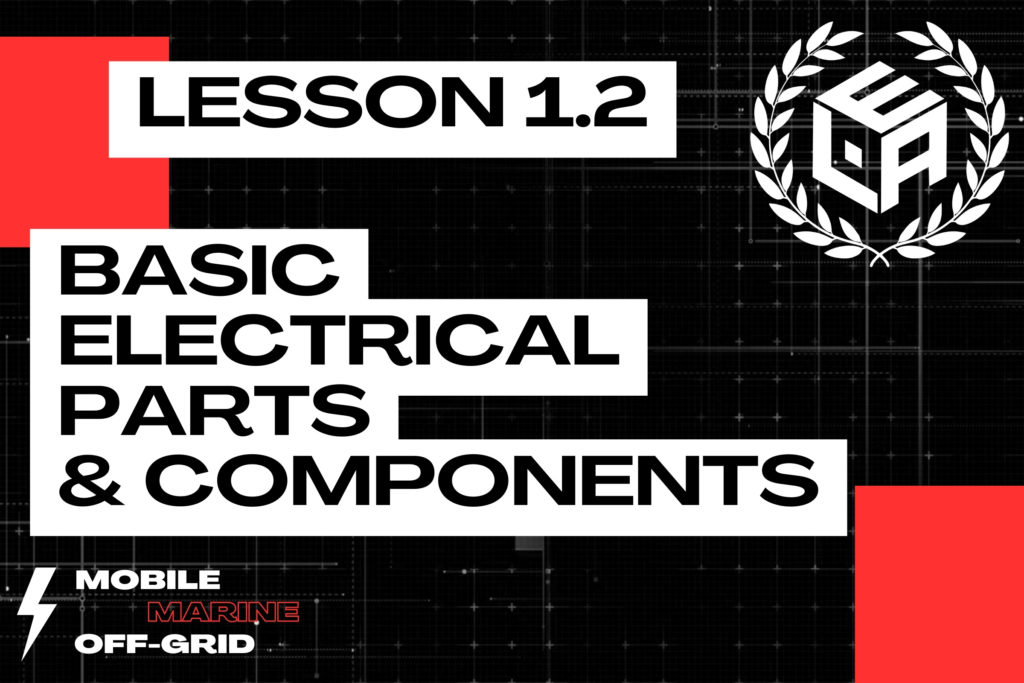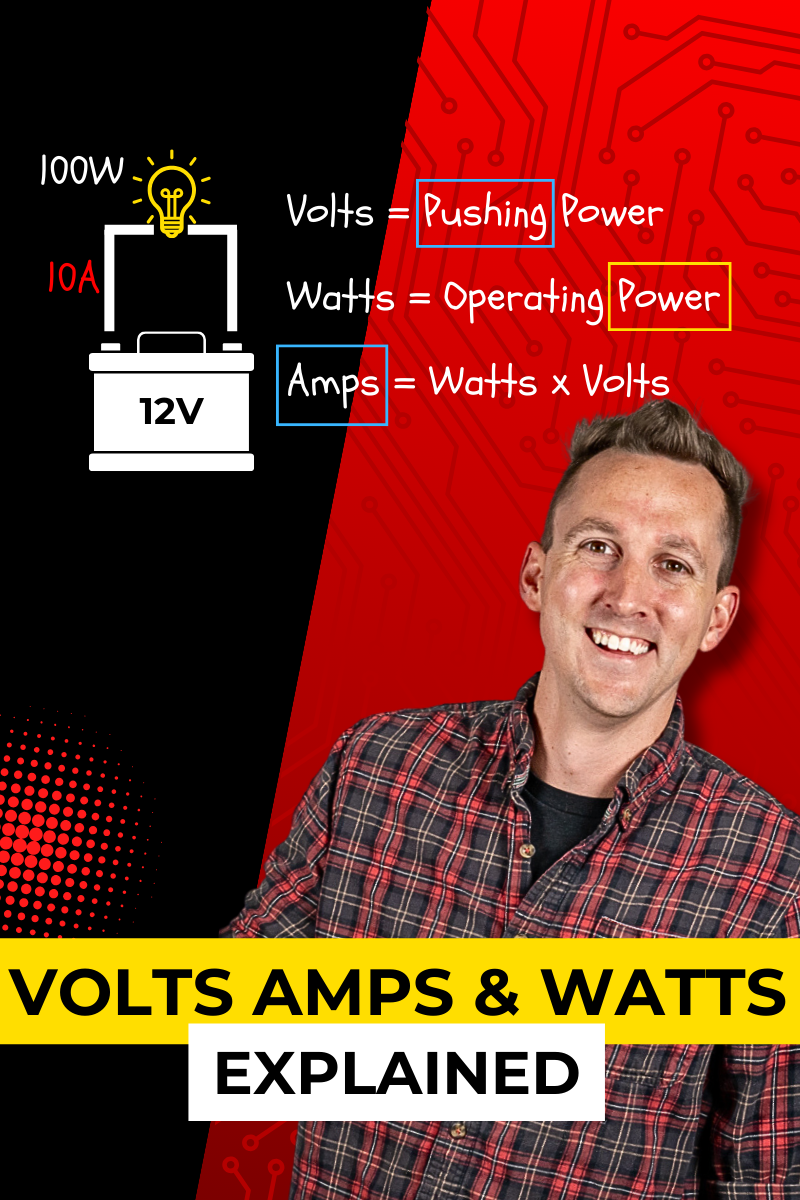We get comments like this… ALL the time on our in-depth electrical installation videos…

and we get it…
there are a lot of terms that need to be understood before you ever cut a wire or pick up a wrench…
Clearing up the confusion surrounding amps, watts, volts and more is exactly what we are going to cover here in Lesson 1.1 of this Electrical Terminology Chapter.

{{Coming Soon}}
Watts is a ‘quantity’ of power. In other words, it’s the amount of power required for something to function.
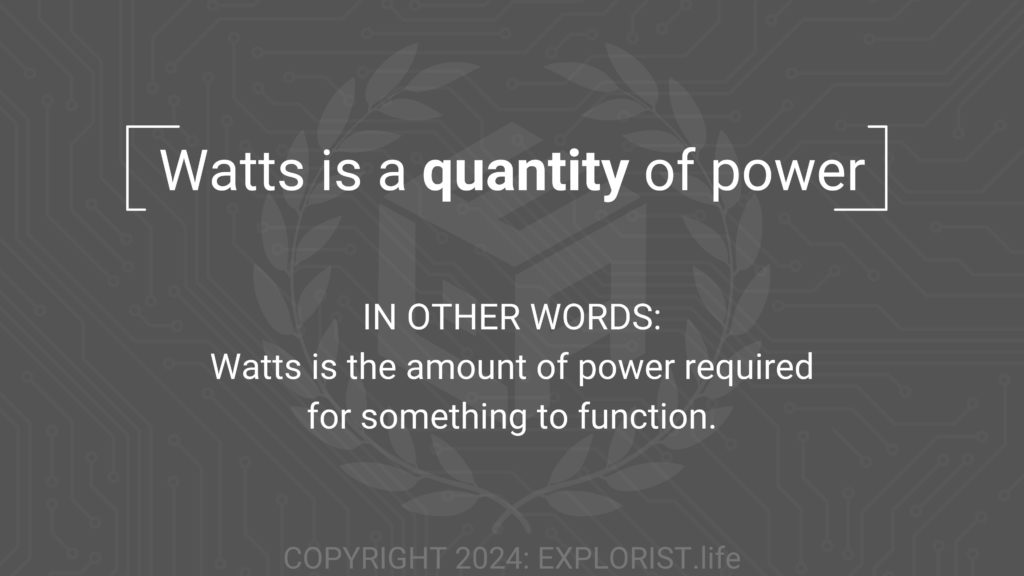
For example, Lightbulbs are all rated at a certain wattage. A 60W lightbulb will ‘ask’ for 60 watts from the power source to shine at its designed output. A larger load, like a space heater, will ‘ask’ for much more power; potentially 1200W for a standard space heater you may plug into a normal wall outlet.
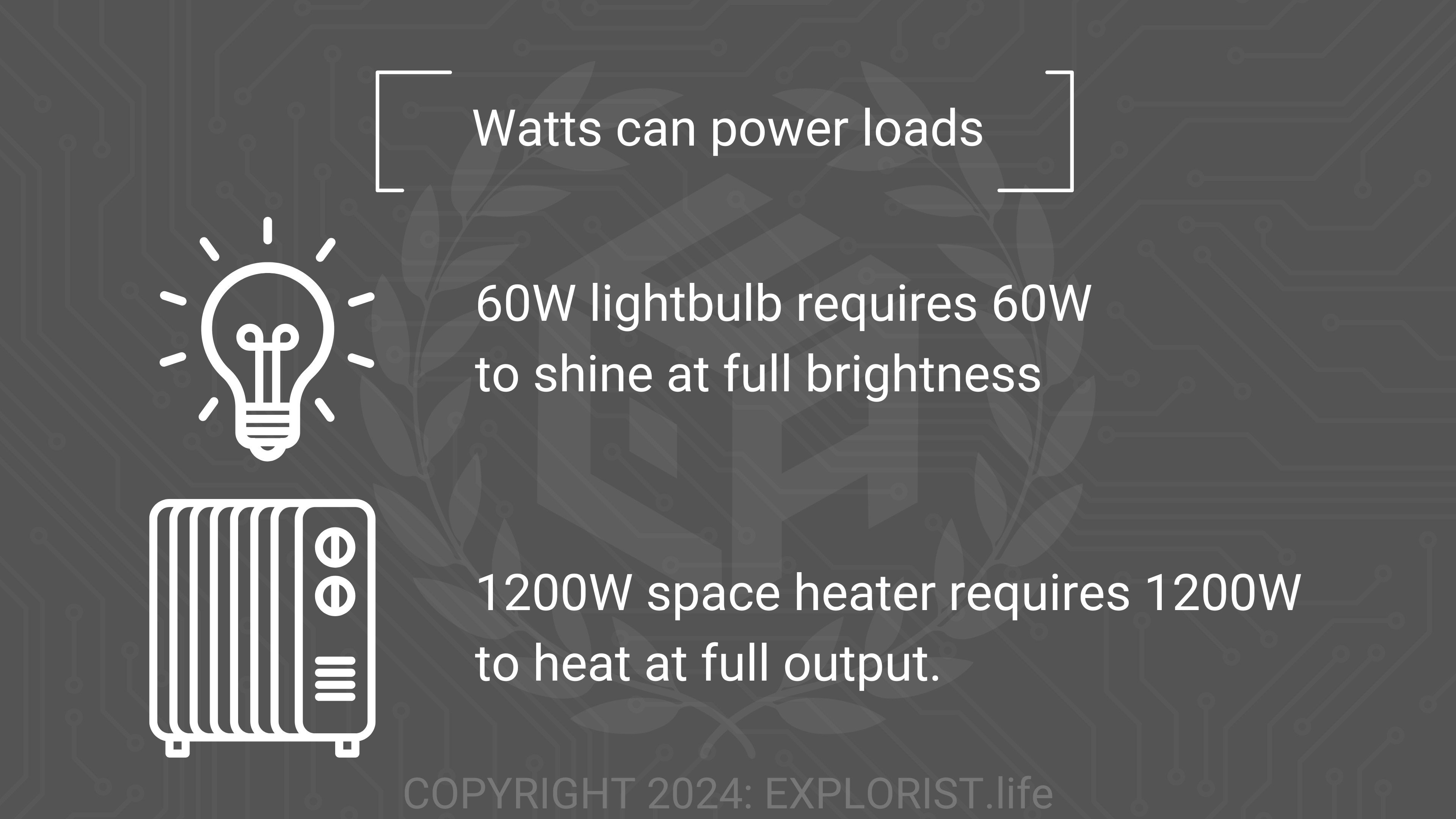
So, understanding that a watt is a ‘quantity’ of power, there are three important ways that watts are used:
- Watts used to power a load
- Watts used as energy storage
- Watts used to recharge a battery bank
How are Watts used to Power Loads?
Watts used to power a load is going to be anything that ‘uses’ power: Light bulbs, space heaters, computers, and I think you can see where I’m going with this. Basically anything you plug in will ‘use’ watts.
How are Watts used as Energy Storage?
Watts used as energy storage is batteries. From rechargeable double AA batteries to cell phones to the batteries in electric vehicles to the battery bank of a Van, RV, or off-grid house. They all store watts until a device asks for those watts to be able to run.
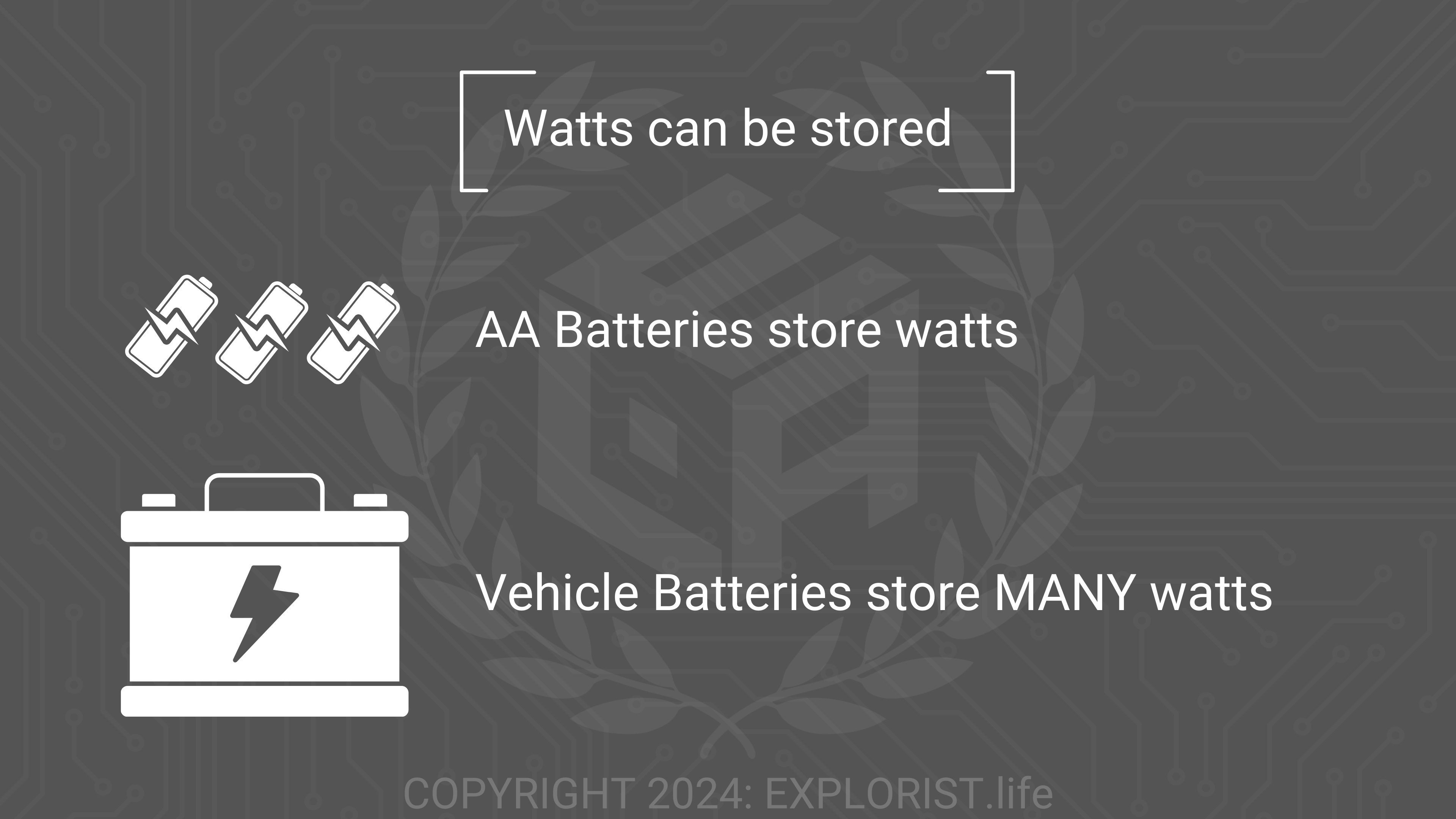
How are Watts used to Recharge Batteries?
Watts are used to recharge a battery bank; the most common example is solar panels.
The sun, at any given time, is putting off just a bit under 383 Septillion (382,800,000,000,000,000,000,000,000) watts of power. We aren’t going to get into the ‘how’ a solar panel works in this video, but all you need to know today is that we can harvest some of those watts with solar panels to recharge a battery, and every solar panel has a specific power rating of how many watts it can harvest at any given time; which is based on how large or small the footprint of the solar panel is.
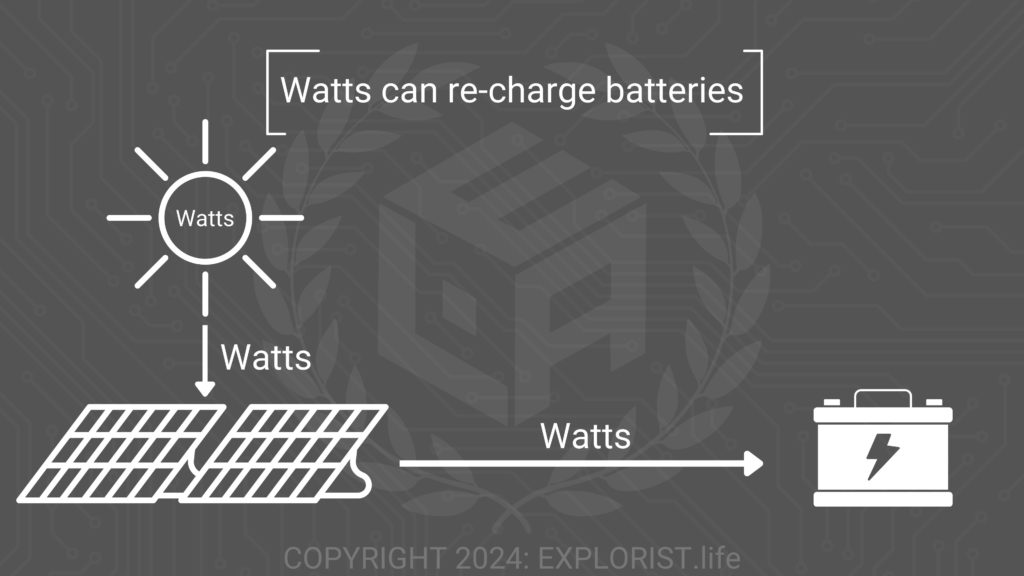
In other words, a 500W solar panel will be roughly 5x the size of a 100W solar panel, and each will recharge a battery at those listed rates under perfect conditions.
Now that you understand watts let’s immediately jump to ‘watt-hours’ because they operate hand-in-hand.
Once you understand a watt, a watt-hour is easy to understand. It is simply the ‘rate’ at which watts are used, gained, or stored, similar to:
- Miles per Gallon or Kilometers per Liter for fuel mileage,
- Beats per minute in music,
- Dollars per hour when it comes to doing work & getting paid for it.
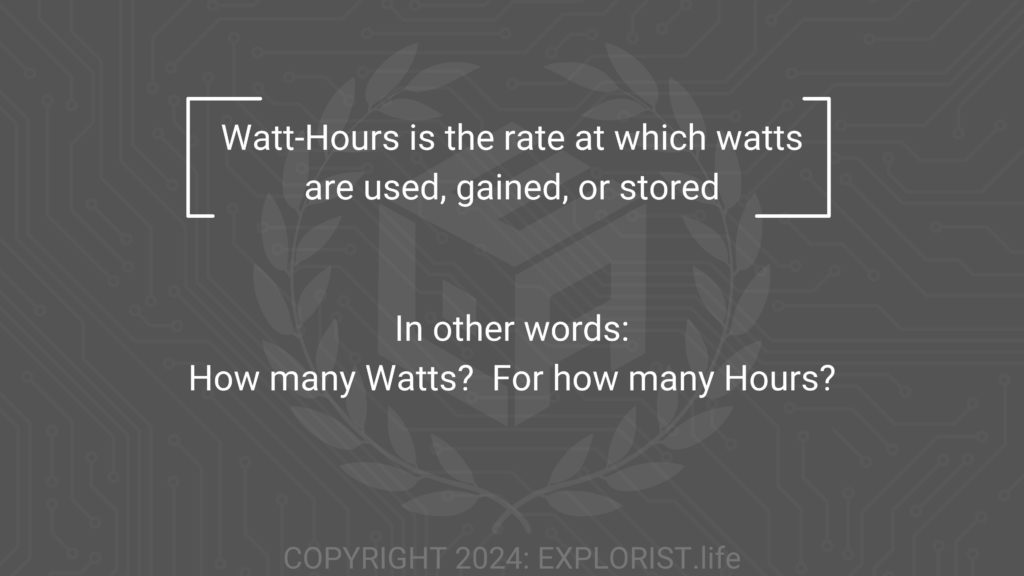
How do Watt-Hours relate to Electrical Loads?
Here are some easy examples of how watt-hours are calculated:
- If you’ve got a 100W light bulb and it’s on for 1 hour, you have used 100W for an hour, which is 100 watt-hours.
- If you’ve got a 100W light bulb and it’s on for 2 hours, you have used 100W for two hours, which is 200 watt-hours.
- If you’ve got a 100W light bulb running for 30 minutes, that’s half an hour, which means we’ve used 100W for a half-hour, which is 50 Watt Hours.
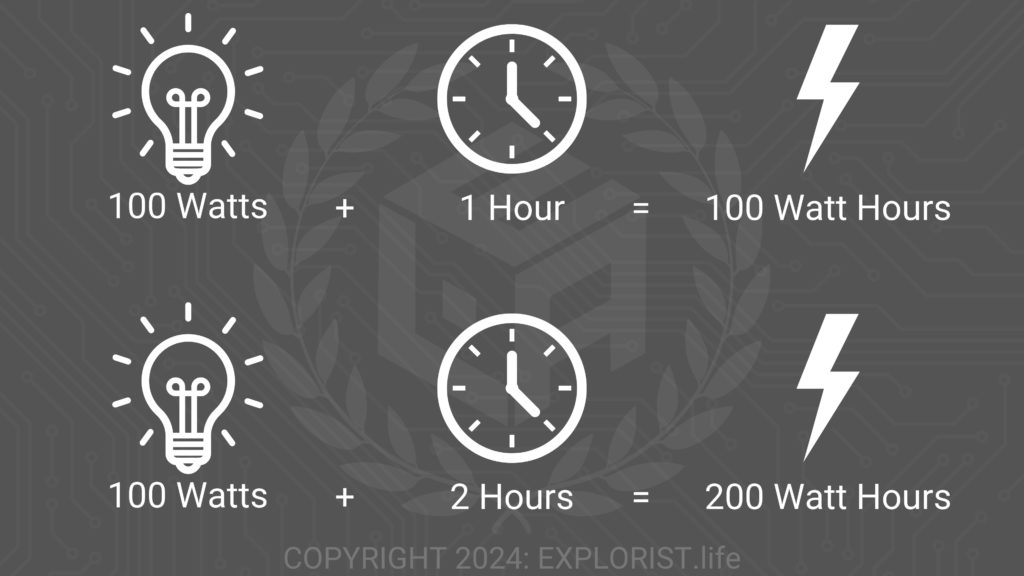
How do Watt-Hours relate to power storage?
If you have a battery rated for 1200 watt-hours, you have 1200 watts stored in that battery, ready for your use. If you connect a 1200W load to your 1200-watt-hour battery and run it for 1 hour; your battery is going to last for 1 hour, because you’ve pulled out 1200W for an hour, aka 1200-watt-hours.
But on the flip side; if you run a 1-watt load, the battery will last for 1200 hours because you’ve pulled out one-watt for 1200 hours aka 1200-watt-hours.
Either way; in that battery, you have 1200Wh available for your use regardless of how fast or slow you use it.
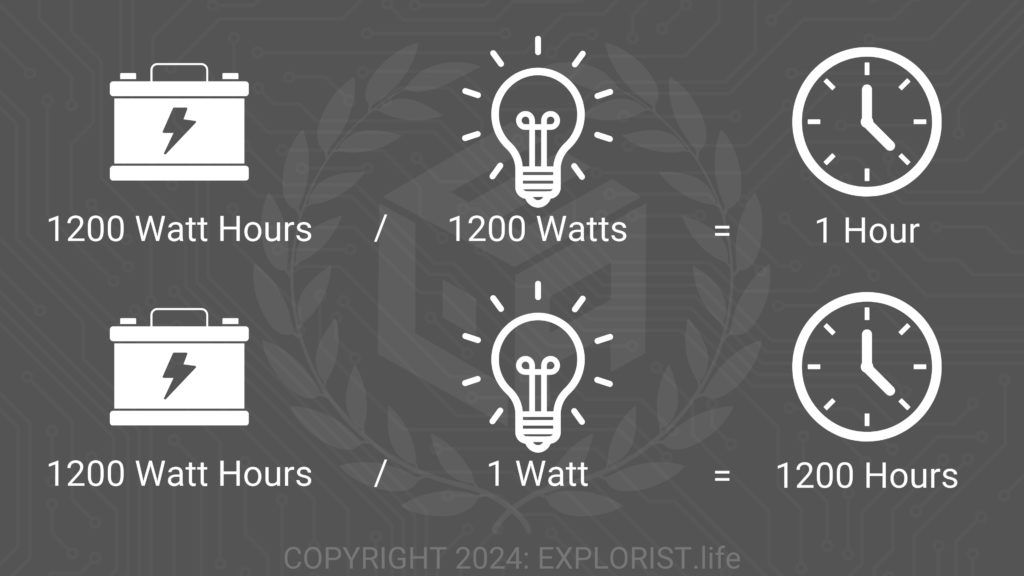
How do Watt-Hours relate to Recharging Batteries?
Watt-hours and recharging batteries is the exact same thing as watt-hours powering a load like we’ve already talked about; just in the opposite direction.
So, if you’ve got a 100W solar panel and it’s producing power for 1 hour; you have generated 100 Watt-hours back into your battery.
If you’ve got a 100W solar panel and it’s producing power for 2 hours; you have generated 200 Watt-hours back into your battery.
100W solar panel for 30 minutes; well, that’s half an hour; which means we’ve gained 100W for a half hour, which is 50 Watt Hours.
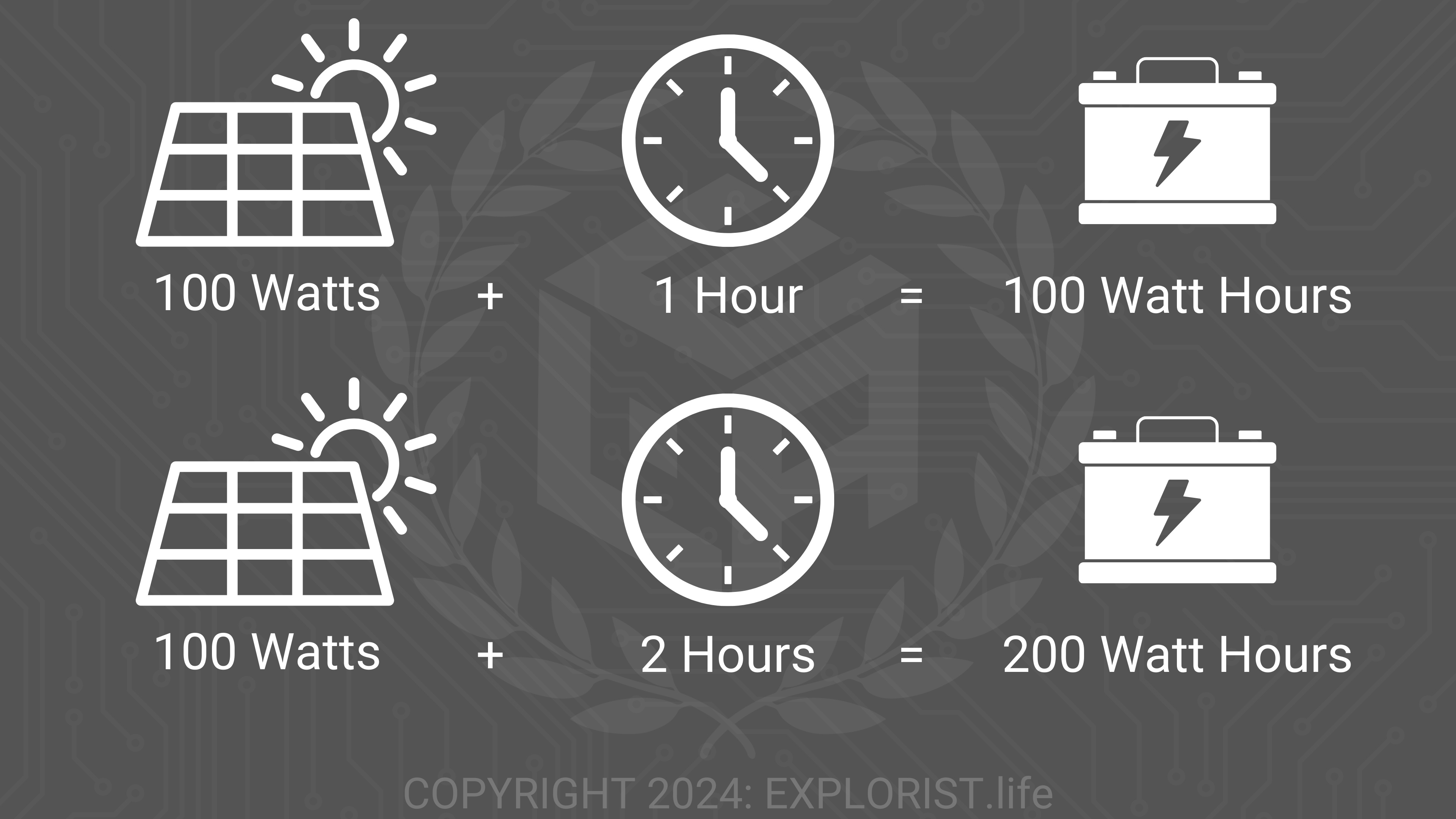
Now, we will go more in-depth on watt-hours in a future video dedicated to it, complete with calculations and spreadsheets; but this is all you need to know for now and will set you up for success when we talk about power audits – later in this academy, so consider subscribing.
Volts is the unit for how hard watts are being pushed.
For example: A standard 12V battery is ‘pushing’ its wattage at 12 volts; which relatively, isn’t very much.
This is why I can touch the positive and negative terminals of a 12V battery without much risk of being shocked.
Now, if I were to stick my fingers into a 120V outlet, I would absolutely be shocked every time. This is because the voltage is ‘pushing’ much harder. So much so that the 120 volts are able to push the wattage all the way through my body, completing the circuit.
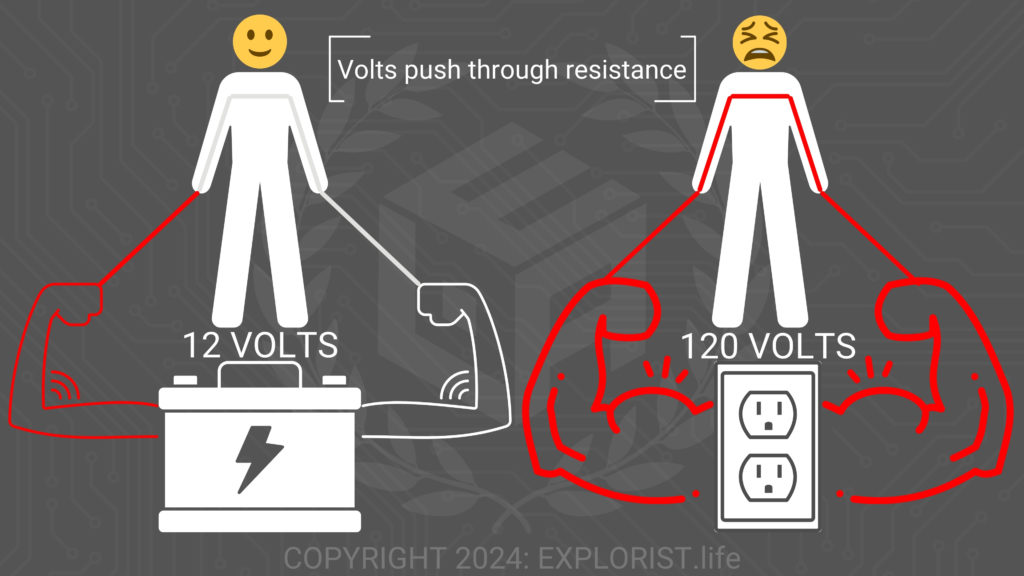
Time for a side-quest to talk about resistance.
Ohms is simply the unit for measuring ‘resistance’ in a circuit. Resistance in a circuit is based on what the circuit is made of.
Copper wires (depending on their thickness) have a resistance of about 1 Ohm.
My skin has a resistance of over 10,000 ohms.
If I had just gotten out of the swimming pool and was soaking wet; my skin’s resistance may be closer to 1,000 ohms.
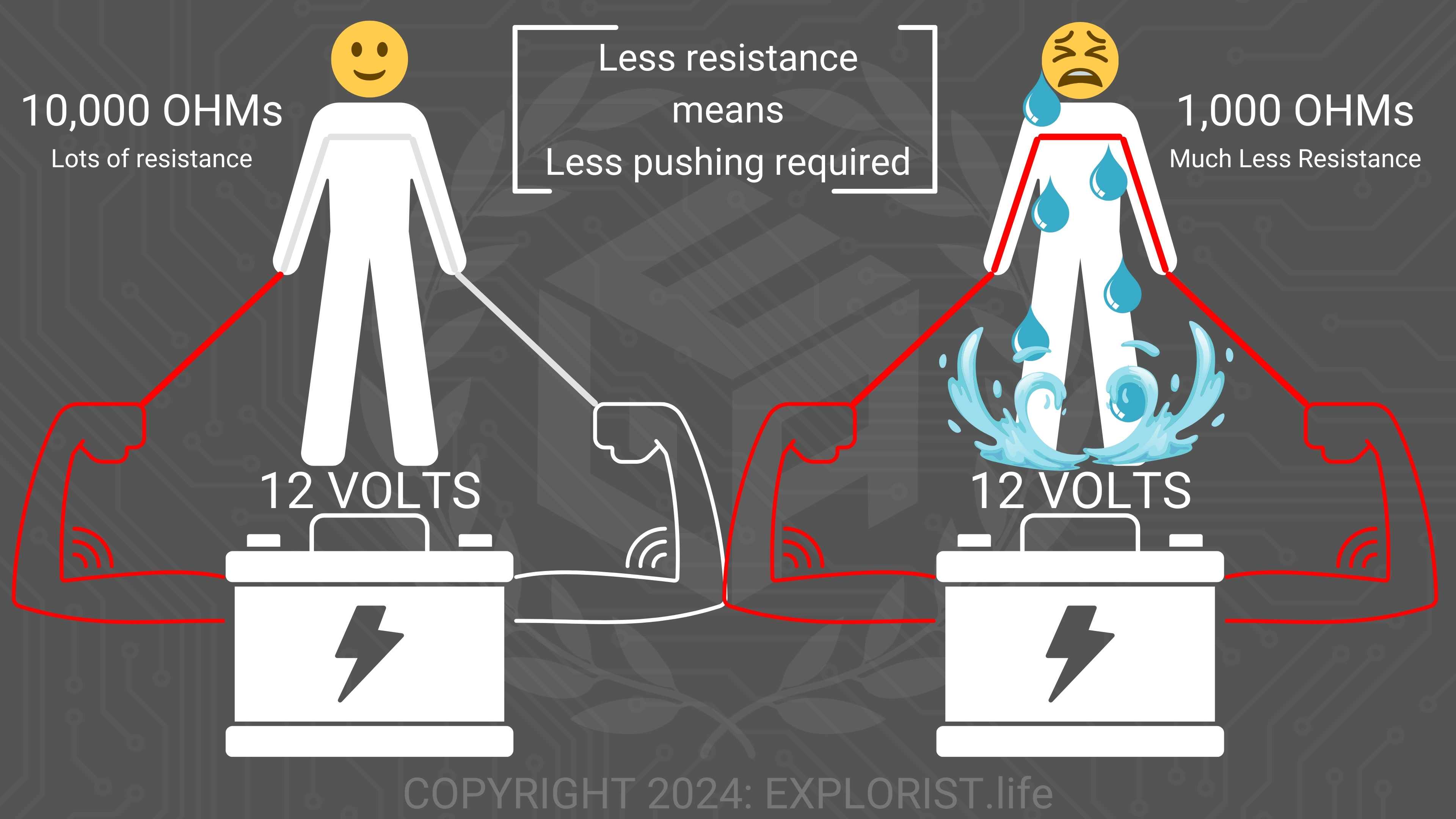
The less resistance a material has, the better it will be for flowing electricity; which is why we use copper as a common material to make wires for carrying electricity. The only metal that is better at carrying electricity is pure silver; which understandably becomes cost-prohibitive.
Now back to Volts:
Pretty much every device is set up to be operated at a particular voltage. Here in the USA, anything that plugs into a standard wall outlet, is designed to operate at 120V (unless there is an inline converter; which converts the 120V to the proper voltage to run the device); This is fortunate; because that is a standardized voltage output across the entirety of the country; and every country will have its own standardized voltage at a wall outlet.
A lot of lower-powered items around a van, RV, or boat are powered by 12V power.
There’s a lot more to understanding voltage; but for now… as long as you understand that Volts is the unit for how hard watts are being pushed, you’ll be in good shape.
And actually, before we move on: It’s also worth noting that if you try to operate a device at too low of a voltage, like a 120V device from 12V; it’s likely just not going to work.
But… on the other hand, if you over-voltage a device, it’s going to break things.
Amps are VERY similar to Watts, but are just more specific.
In order to find amps, we can simply divide the operating wattage of a device by its operating voltage, which gives us its amperage.
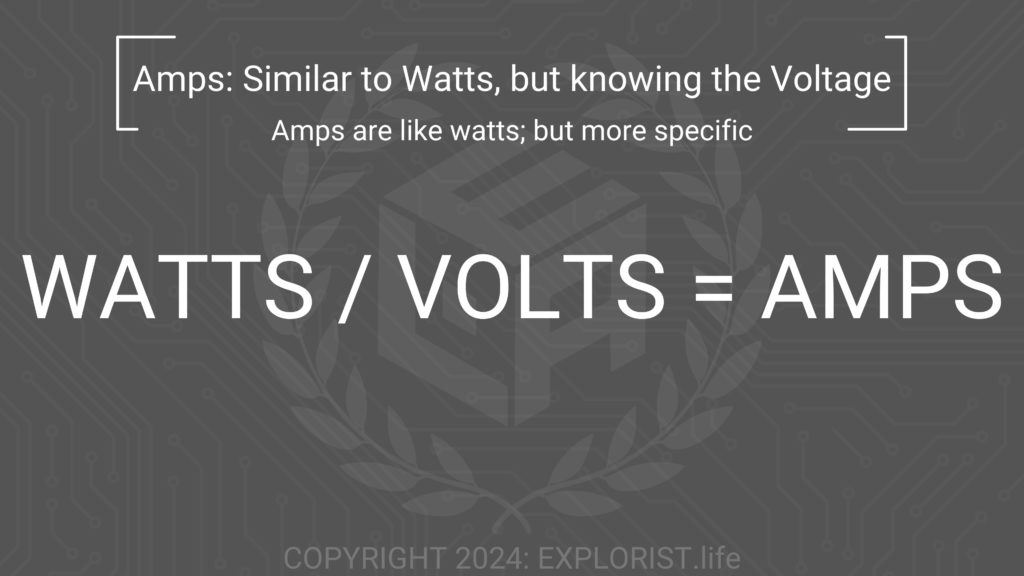
In other words, the amps are simply the wattage of a device with a secondary understanding of how hard those watts are being pushed by the operating voltage.
Why are amps important?
The main place we use amps is when determining the wire size that needs to supply power to a device or outlet.
Every wire size has a specific amperage rating attached to it, and the bigger the wire, the more amps it can flow.
If we are powering a 12V 1200W load from a 12V battery; that is 100A!
If we are powering a 120V 1200W load from a 120V wall outlet; that is only 10A.
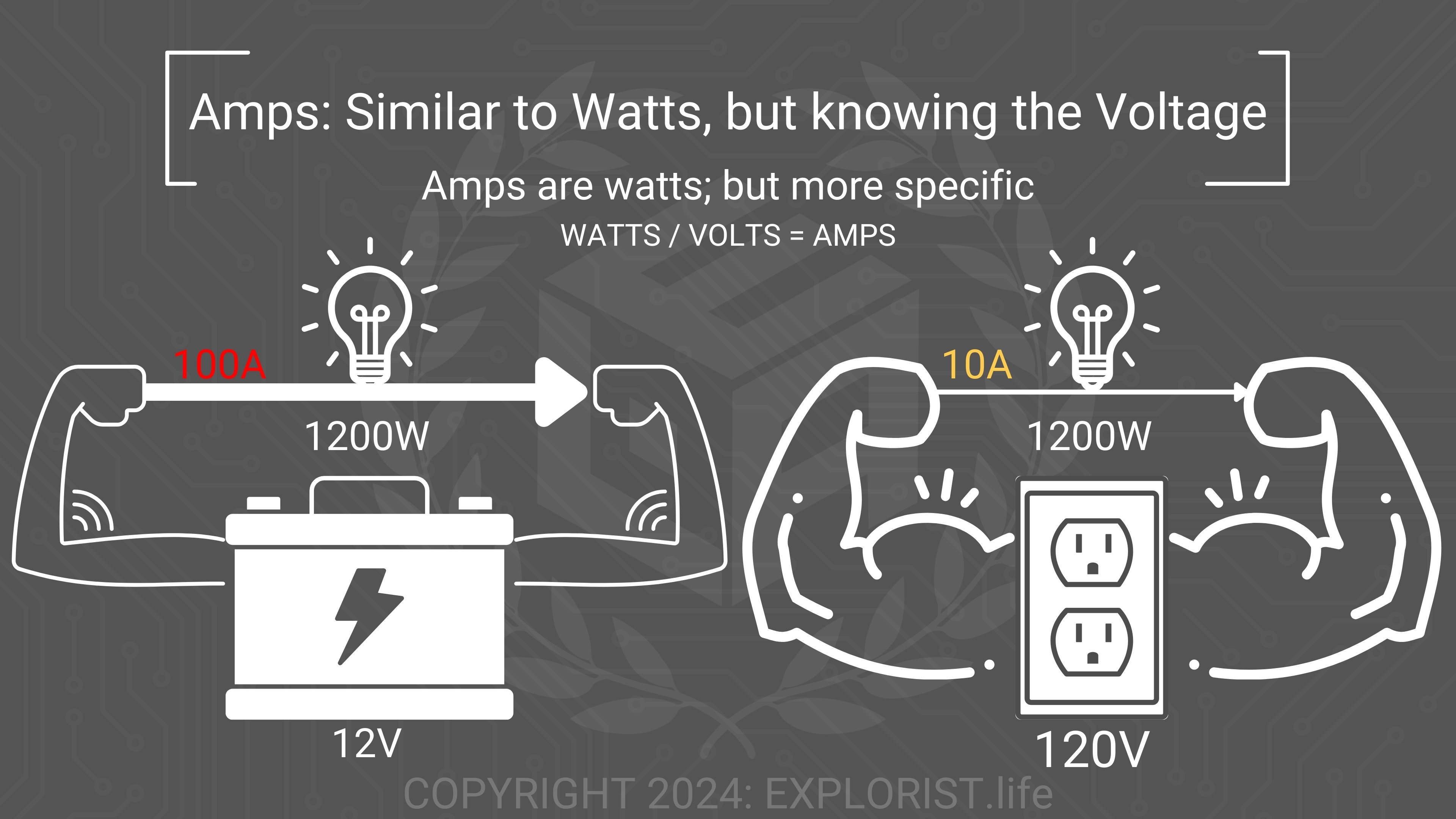
Both the same amount of watts, both delivered at different voltages, both requiring different wire sizes.
We will cover wire sizing in a dedicated video during this academy, but this is one of the main reasons why amps are important.
An amp-hour is nearly the exact same concept as the watt-hour we’ve already discussed: it is simply the ‘rate’ at which amps are used, gained, or stored.
Why are Amp Hours Important?
Most batteries for off-grid electrical systems list their power storage as amp hours.
If we know that we have a 100Ah 12V Battery, this means that we can pull 100 amps from that battery for 1 hour, or 50 amps from that battery for 2 hours. The math on the concept of amp hours vs. watt-hours is the exact same.
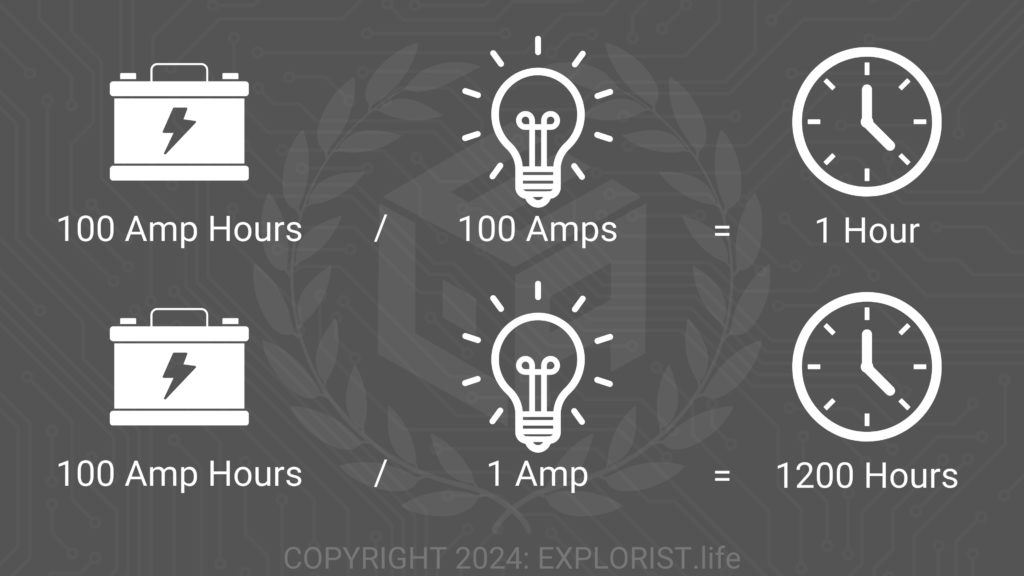
Now, I already know that SparkyChuck764 is going to be yelling at me through the screen saying:
“I got my electrical engineering degree in 1746 and have been a licensed master chancellor electrician supreme for 75 years and you didn’t talk about how Pukert Exponents and C Ratings!”
…and that’s correct, Chuck… I purposely skipped over some of the more complicated concepts in regards to amp hours and battery drain in the spirit of keeping this video beginner-friendly. So for everybody else, just understand that there’s more to know about these concepts but we have to start somewhere and we will build on these concepts later, but for now; this is all you need to know.
AC and DC current stands for ‘Alternating Current’ and ‘Direct Current’, and all we need to know for basic understanding is that they are two flavors, if you will, of power. AC current comes out of Inverters to power standard household devices like Blenders and induction cooktops. DC power comes from a battery and is more common for 12V devices like puck lights and USB outlets.
Now; there are DC-powered devices like our phones that have an AC to DC converter built right onto the charger to convert from one flavor of power to the other.
These two types of currents are typically seen listed as VAC and VDC; or Volts of Alternating Current or Volts of Direct Current.
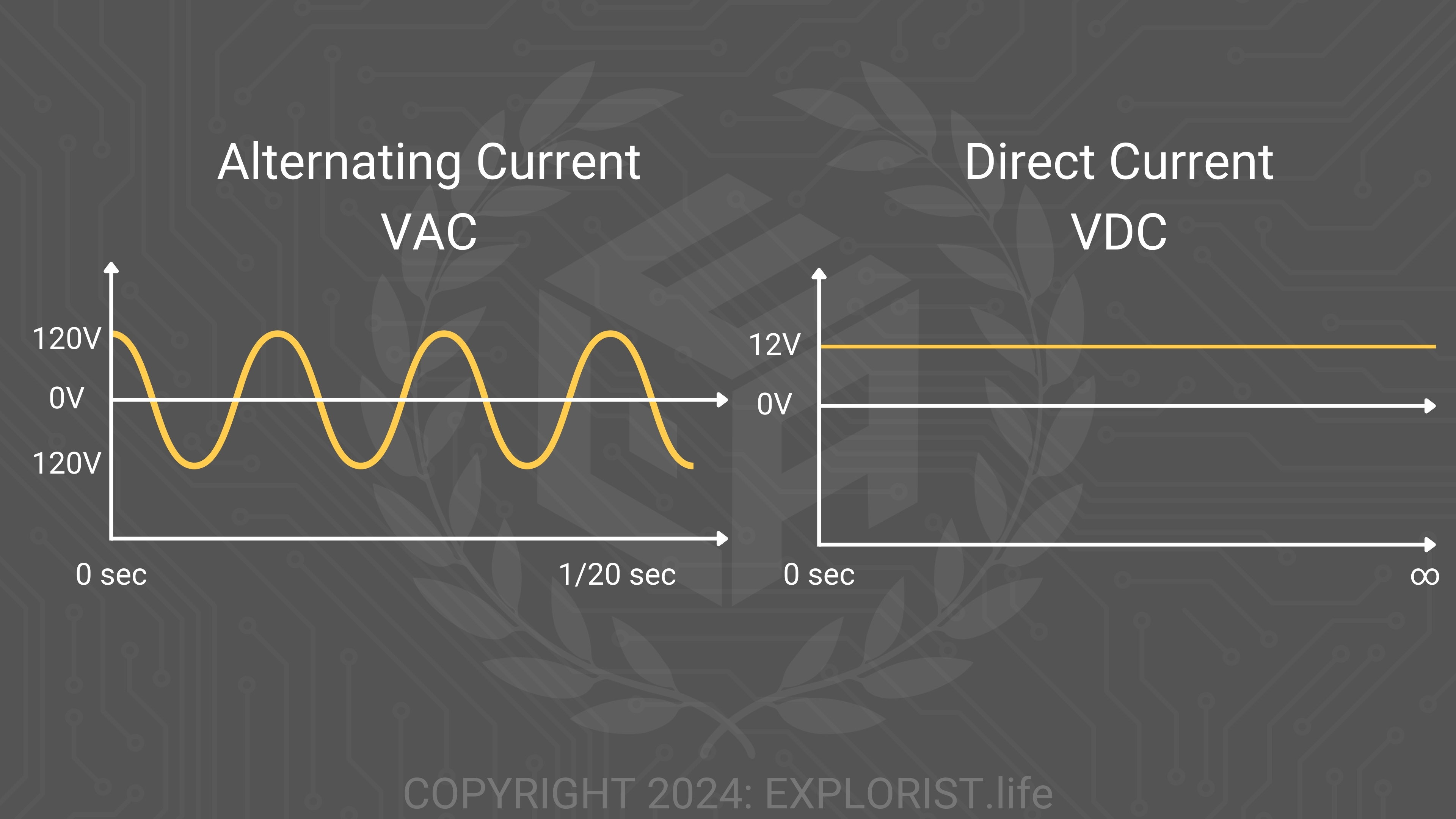
For example: There are both AC and DC air conditioners, so if for some reason, you stumbled across an air conditioner and had no idea of what flavor of power it needed to run; you could look on the specification sticker and it would say 120VAC which would mean that it needs 120 volts of alternating current to run; which would mean it would need to be behind a DC to AC inverter in an off-grid electrical system. We will talk more about Inverters in an upcoming video.
Alternatively, an air conditioner labeled as 12VDC could be powered directly from a 12V battery bank with no additional conversions necessary.
Now, those are the main terms that I find useful when talking about off-grid electrical systems and will form the backbone of this academy, so be sure to bookmark this lesson and come back to it for a refresher when needed.
Unfortunately, all of these terms don’t really mean much unless we can apply them to something we can use, so in Lesson 1.2 I’m going to teach you about all of the basic parts & components of an electrical system like inverters, solar charge controllers, batteries, fuses, shunts, and much more so that we can start putting these concepts to use. I’ll see you over there:
